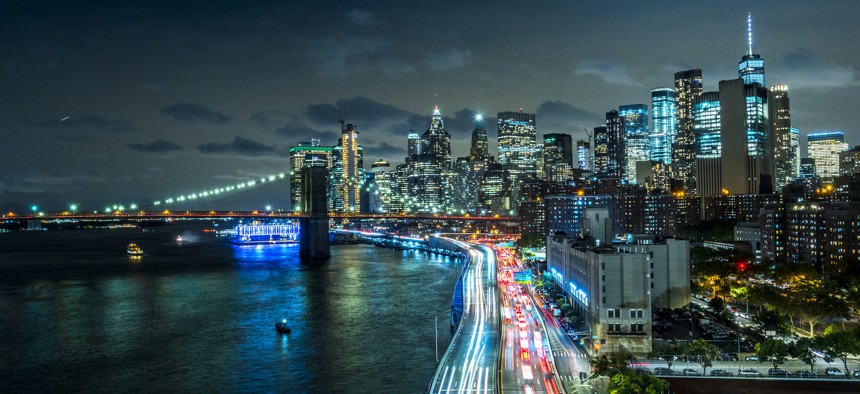Heard Around Town
Transit groups call for congestion toll to be passed on to for-hire vehicle riders
A six-member Traffic Mobility Review Board will meet on Wednesday to develop recommendations on a toll structure for congestion pricing.

Traffic along the FDR Drive in Lower Manhattan pidjoe, E+/Getty Images
Congestion pricing has finally received the green light from federal officials, but before New York can put the tolling system in place, an appointed board must make recommendations on how much tolls will cost and what, if any, exemptions will be added to the program.
A six-member Traffic Mobility Review Board will meet on Wednesday to develop recommendations on a toll structure, with the price of tolls, an off-peak structure and the possibility of additional exemptions still undecided. The 2019 congestion pricing law mandates only three exemptions – for emergency vehicles, qualifying vehicles carrying people with disabilities and residents of the congestion zone (Manhattan below 60th Street) who earn $60,000 or less annually. The Metropolitan Transportation Authority has also said it would offer a discount to other low-income drivers who travel often into the congestion zone to mitigate potential adverse effects of the program.
The Traffic Mobility Review Board will ultimately make its recommendations to the state’s Triborough Bridge and Tunnel Authority, which is responsible for adopting the tolling structure. But plenty of interested parties are making their own recommendations to the first panel ahead of their Wednesday meeting.
In a letter shared with City & State, a coalition of transit, urban policy, environmental and other advocacy groups called on the board to make recommendations that would discourage toll shopping, exempt commuter buses and levy a per-ride surcharge on for-hire vehicle trips to be passed along to passengers, among other recommendations.
The Congestion Pricing Now Coalition, which includes Riders Alliance, the New York League of Conservation Voters, the Regional Plan Association and more than two dozen other groups, is recommending that passengers in for-hire vehicles like Ubers and Lyfts be responsible for paying the congestion pricing toll for their trip as a surcharge.
This diverges from the MTA’s Environmental Assessment, which noted that taxis and for-hire vehicles should be charged no more than once per day under congestion pricing. “Our coalition firmly believes that eliminating the once-per-day toll and replacing it with a per-ride surcharge will do far more to reduce congestion, protect drivers, and generate revenue for public transit,” the letter read.
The coalition, however, wants to see taxis receive a special consideration, writing that a per-ride surcharge shouldn’t be applied to taxi trips. “Taxi drivers have suffered greatly and are already burdened by the investments taxi owners have made in medallions that are now valued at significantly less than the original investment,” the letter read.
Taxi rides south of 96th street in Manhattan, along with for-hire vehicle rides, already carry a congestion surcharge – $2.50 for yellow cabs and $2.75 for services like Uber and Lyft – implemented in 2019. Those fees are passed onto passengers.
The Congestion Pricing Now Coalition is also eager to cut down on potential “toll shopping” – driving out of the way to access Manhattan through untolled crossings like the Brooklyn Bridge rather than tolled crossings, which could cause increased congestion and environmental burdens for the neighborhoods around those crossings. “In order to do this, the congestion pricing program will need to apply toll credits, or off-sets, to reduce any incentive to drive further to avoid a particular toll as much as possible,” the letter reads.
The coalition’s letter goes on to recommend that trucks and large vehicles should be charged more than passenger vehicles, on a per-axle rate. It also recommends an exemption for commuter buses, noting that a goal of the program is to disincentivize personal vehicle use, not mass transit. Beyond that, the coalition doesn’t want to see any other exemptions beyond the legislatively mandated ones – and the discounts laid out by the MTA – applied.
The meeting of the Traffic Mobility Review Board on Wednesday follows several rounds of public meetings and hearings across the metropolitan area on the congestion pricing program.

